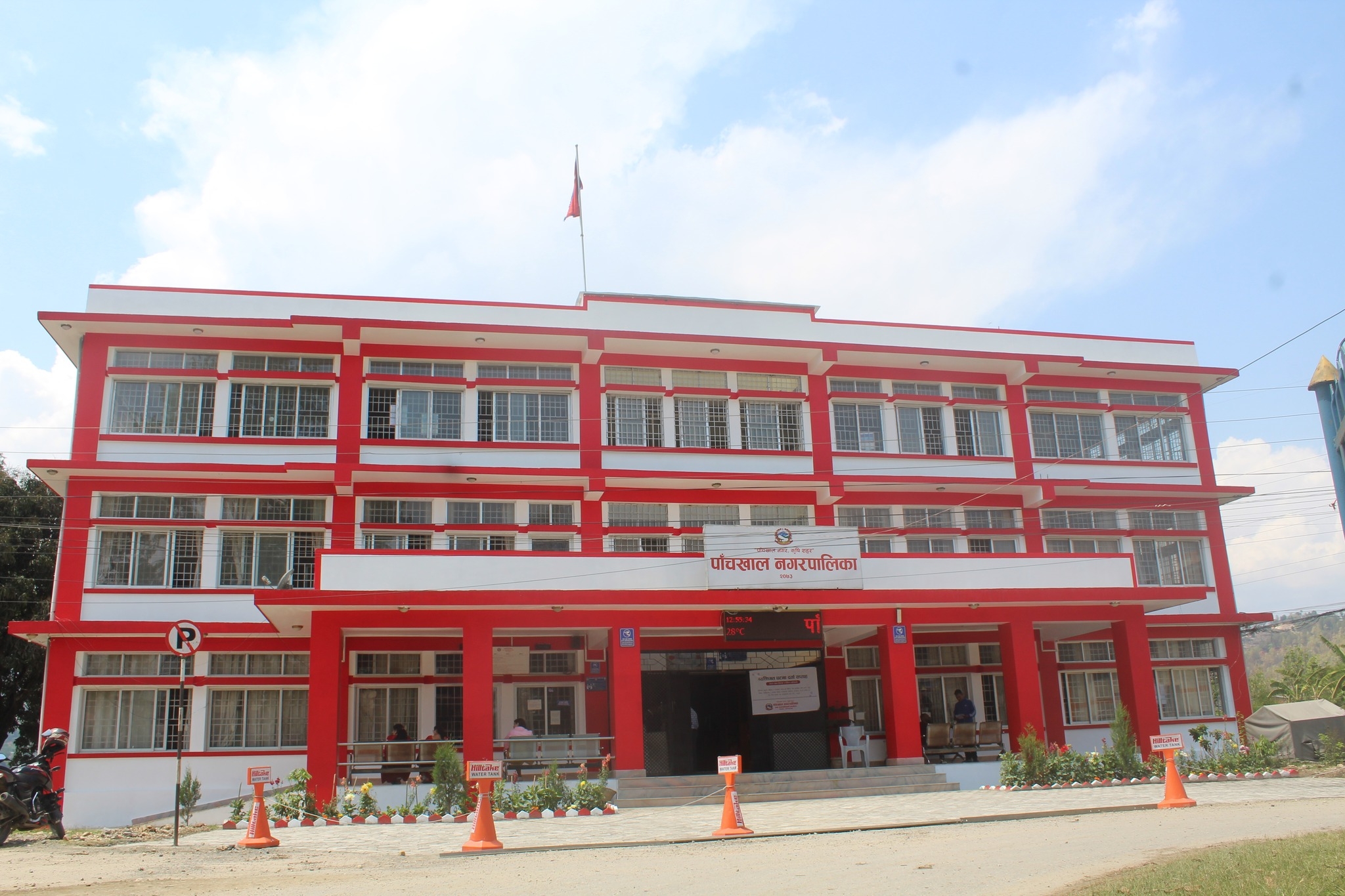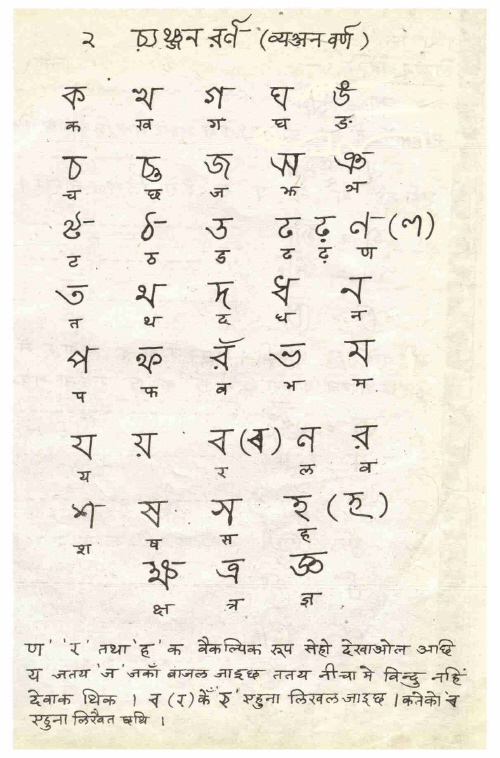|
Panchkhal Valley
Panchkhal () is a Municipality in Kavrepalanchok District in the Bagmati Province of central Nepal. Panchkhal has an area of 103 km2 and population density of 386.6/km2, according to the 2011 census. Glacial strand retreat and fluvial incision led to develop landscapes and evolve the area having a relief of about 122 to 750 m. At the time of the 2011 Nepal census it had a population of 35340 in 8948 households combining of the previous VDCs that were merged. Previous Anaikot, HokseBazar, Kharelthok, Koshidekha, Baluwa & Panchkhal VDCs was merged to form the agriculturally rich Panchkhal Municipality with the motto of "''पाँचखाल नगर, कृषि शहर'' (''Panchkhal Municipal-Agriculture City)''". Demographics At the time of the 2011 Nepal census, Panchkhal Municipality had a population of 39,788. Of these, 76.6% spoke Nepali, 20.9% Tamang, 11.6% Danuwar, 8.6% Newar, 0.3% Maithili, 0.2% Bhojpuri, 0.2% Rai, 0.1% Hindi, 0.1% Magar and 0.2% ... [...More Info...] [...Related Items...] OR: [Wikipedia] [Google] [Baidu] |
Municipality
A municipality is usually a single administrative division having municipal corporation, corporate status and powers of self-government or jurisdiction as granted by national and regional laws to which it is subordinate. The term ''municipality'' may also mean the governing body of a given municipality. A municipality is a general-purpose administrative subdivision, as opposed to a special district (United States), special-purpose district. The English language, English word is derived from French language, French , which in turn derives from the Latin language, Latin , based on the word for social contract (), referring originally to the Latin communities that supplied Rome with troops in exchange for their own incorporation into the Roman state (granting Roman citizenship to the inhabitants) while permitting the communities to retain their own local governments (a limited autonomy). A municipality can be any political jurisdiction (area), jurisdiction, from a sovereign state s ... [...More Info...] [...Related Items...] OR: [Wikipedia] [Google] [Baidu] |
Deuvumi Baluwa
Dewabhumi Baluwa is a market place in Panchkhal Municipality in Kabhrepalanchok District in Bagmati Province of central Nepal. It was merged to form the new municipality along with Panchkhal, Deuvumi Baluwa, Anaikot and Sathighar Bhagawati village development committee on 18 May 2014. At the time of the 1991 Nepal census The 1991 Nepal census was a widespread national census conducted by the Nepal Central Bureau of Statistics. Working with Nepal's Village Development Committees at a district level, they recorded data from all the main towns and villages of each ... it had a population of 6773 . References External linksUN map of the municipalities of Kavrepalanchok District Populated places in Kavrepalanchok District {{Kavrepalanchok-geo-stub ... [...More Info...] [...Related Items...] OR: [Wikipedia] [Google] [Baidu] |
Newar People
Newar (; , endonym: Newa; , Pracalit script: ), or Nepami, are primarily inhabitants in Kathmandu Valley of Nepal and its surrounding areas, and the creators of its historic heritage and civilisation. Page 15. Newars are a distinct linguistic and cultural group, primarily Indo-Aryan peoples, Indo-Aryan and Tibeto-Burman migration to Indian subcontinent, Tibeto-Burman ethnicities, who share a common language, Newar language, Nepal Bhasa, and predominantly practice Newar Hinduism and Newar Buddhism. Newars have developed a division of labour and a sophisticated urban civilisation not seen elsewhere in the Himalayas, Himalayan foothills. Newars have continued their age-old traditions and practices and pride themselves as the true custodians of the religion, culture and civilisation of Nepal. Newars are known for their contributions to culture, Newa art, art and Newari literature, literature, Lhasa Newar, trade, Agriculture in Nepal, agriculture and Newa cuisine, cuisine. Today, th ... [...More Info...] [...Related Items...] OR: [Wikipedia] [Google] [Baidu] |
Tamang People
The Tamang people (; Devanagari: तामाङ; ''tāmāṅ'') are an ethnic group living in Nepal, Northeast India and southern Bhutan. In Nepal, they are concentrated in the central hilly and Himalayan regions and constituted over 1.6 million people in the 2021 census. In India, Tamang people live in the state of Sikkim, in the Darjeeling district, Darjeeling and Kalimpong districts of West Bengal and in Assam. In Bhutan, they live foremost in the southern foothills including Tsirang District, Dagana District, Samtse District, Chukha District, Sarpang District and Samdrup Jongkhar District. The Tamang language is the fifth most-spoken language in Nepal. History Research indicates that the Tamang people are a hybrid ethnic group with an estimated 59% genetic contribution from Tibetan and 41% from Nepalese ancestries. The Tamangs have been mentioned in various Nepalese and colonial historical records under a variety of names, such as ''Bhote'', ''Bodh'', ''Lama'', ''Murmi' ... [...More Info...] [...Related Items...] OR: [Wikipedia] [Google] [Baidu] |
Bahun
Bahun (), also known as Hill Brahmins, are a Brahmin varna among the Khas of Nepal. They are a sub-caste of the Kanyakubja Brahmin while their origins are from Kannauj and the Himalayan belt of South Asia. According to the 2011 Nepal census, Bahun is the second most populous group after Chhetri. According to 1854 ''Muluki Ain'', the first Nepalese civil code, Bahuns were regarded as caste among sacred thread bearers ( Tagadhari) and twice-born Hindus. Origin Traditionally, Bahuns were members of the Khas community together Chhetris. Possibly due to political power of the Khasa Malla kingdom, Khas Brahmins and Khas Kshatriyas had high social status in the present-day western Nepal. Bahuns, regarded as upper class Khas group together with Chhetris, were associated mostly with the Gorkha Kingdom and its expansion. There appears to be general agreement in historical records and family genealogy that Hill Brahmins (both Purbia and Kumai Bahuns) migrated from the G ... [...More Info...] [...Related Items...] OR: [Wikipedia] [Google] [Baidu] |
Magar Language
Magar Dhut (, ) is a Sino-Tibetan language spoken mainly in Nepal, southern Bhutan, and in Darjeeling, Assam and Sikkim, India, by the Magar people. It is divided into two groups (Eastern and Western) and further dialect divisions give distinct tribal identity. In Nepal 810,000 people speak the language. While the government of Nepal developed Magar language curricula, as provisioned by the constitution, the teaching materials have never successfully reached Magar schools, where most school instruction is in the Nepali language. It is not unusual for groups with their own language to feel that the "mother-tongue" is an essential part of identity. The Dhut Magar language is sometimes lumped with the Magar Kham language spoken further west in Bheri, Dhaulagiri, and Rapti zones. Although the two languages share many common words, they have major structural differences and are not mutually intelligible. Geographical distribution Western Magar Western Magar (dialects: ''Pal ... [...More Info...] [...Related Items...] OR: [Wikipedia] [Google] [Baidu] |
Hindi
Modern Standard Hindi (, ), commonly referred to as Hindi, is the Standard language, standardised variety of the Hindustani language written in the Devanagari script. It is an official language of India, official language of the Government of India, alongside English language, English, and is the ''lingua franca'' of North India. Hindi is considered a Sanskritisation (linguistics), Sanskritised Register (sociolinguistics), register of Hindustani. Hindustani itself developed from Old Hindi and was spoken in Delhi and neighbouring areas. It incorporated a significant number of Persian language, Persian loanwords. Hindi is an Languages with official status in India, official language in twelve states (Bihar, Gujarat , Mizoram , Maharashtra ,Chhattisgarh, Haryana, Himachal Pradesh, Jharkhand, Madhya Pradesh, Rajasthan, Uttar Pradesh, Uttarakhand), and six Union territory, union territories (Andaman and Nicobar Islands, Delhi, Chandigarh, Dadra and Nagar Haveli and Daman and Di ... [...More Info...] [...Related Items...] OR: [Wikipedia] [Google] [Baidu] |
Kiranti Languages
The Kiranti languages are a major family of Sino-Tibetan languages spoken in Nepal and India (notably Sikkim, Darjeeling, Kalimpong, and Bhutan) by the Kirati people. External relationships George van Driem had formerly proposed that the Kiranti languages were part of a Mahakiranti family, although specialists are not completely certain of either the existence of a Kiranti subgroup or its precise membership. LaPolla (2003), though, proposes that Kiranti may be part of a larger " Rung" group. Classification There are about two dozen Kiranti languages. Among the better known are Limbu, Sunuwar, Bantawa, Chamling, Khaling, Bahing, Yakkha, Wayu, Dungmali, Lohorung, and Kulung. Kiranti verbs are not easily segmentable, due in large part to the presence of portmanteau morphemes, crowded affix strings, and extensive (and often nonintuitive) allomorphy. Thus their relationship to each other has been a subject of debate. Overall, Kiranti languages are classified: ... [...More Info...] [...Related Items...] OR: [Wikipedia] [Google] [Baidu] |
Bhojpuri Language
Bhojpuri (IPA: ; Devanagari: , Kaithi: ) is an Indo-Aryan language native to the Bhojpuri region, Bhojpur-Purvanchal region of India and the Terai region of Nepal.:ethnologue:bho, Bhojpuri Ethnologue World Languages (2009) It is chiefly spoken in eastern Uttar Pradesh, western Bihar, and northwestern Jharkhand in India, as well as western Madhesh Province, Madhesh, eastern Lumbini Province, Lumbini. It is also a minority language in Fiji, Mauritius, Suriname and historically primarily in the Natal (province), Natal province of South Africa. Fiji Hindi, an official language of Fiji, is a dialect of Bhojpuri spoken by the Indo-Fijians. Caribbean Hindustani is spoken by the Indo-Caribbean people in Guyana, Suriname, Jamaica and Trinidad and Tobago. In Mauritius, it is a recognised by the government and taught in university as well. Bhojpuri language is listed as potentially vulnerable language, vulnerable in the UNESCO World Atlas of Languages. Name The oldest presence of the ... [...More Info...] [...Related Items...] OR: [Wikipedia] [Google] [Baidu] |
Maithili Language
Maithili ( , ) is an Indo-Aryan language spoken in parts of India and Nepal. It is native to the Mithila region, which encompasses parts of the eastern Indian states of Bihar and Jharkhand as well as Nepal's Koshi Province, Koshi and Madhesh Provinces. It is one of the 22 scheduled languages of India. It is the second most commonly spoken native languages of Nepal, Nepalese language constitutionally registered as one of the fourteen provincial official languages of Nepal. It is spoken by 21.7 million people. Of those, 3.2 million are Nepalis, Nepalese speakers. The language is predominantly written in Devanagari, but the historical Tirhuta script, Tirhuta and Kaithi scripts retained some use until today. Official status In 2003, Maithili was included in the 8th Schedule, Eighth Schedule of the Indian Constitution as a recognised language of India, Indian language, which allows it to be used in education, government, and other official contexts in India. The Maithili language i ... [...More Info...] [...Related Items...] OR: [Wikipedia] [Google] [Baidu] |
Newar Language
Newar (; , ) is a Sino-Tibetan languages, Sino-Tibetan language spoken by the Newar people, the indigenous inhabitants of Nepal Mandala, which consists of the Kathmandu Valley and surrounding regions in Nepal. The language is known officially in Nepal as Nepal Bhasa, a name that has been historically used for the language. The term "Newari" is also used to refer to the language, although the Indic ''-i'' suffix is considered inappropriate by some Newar speakers. The language served as the official language of Nepal during the Malla dynasty (Nepal), Malla dynasty since the 14th century till the end of dynasty in 1769 during which the language was referred as "Nepal Bhasa", a term which literally means "Nepalese Language". However, the language is not the same as Nepali language, Nepali, an Indo-Aryan languages, Indo-Aryan language and the current official language of Nepal, which only got the name Nepali in the 1930s. Newar literature, Literature in Newar is one of the oldest i ... [...More Info...] [...Related Items...] OR: [Wikipedia] [Google] [Baidu] |
Danwar Language
Danuwar (also rendered ''Danwar'', ''Denwar'', ''Dhanvar'', ''Dhanwar'') is a language spoken in parts of Nepal by Danuwar ethnic group. It is close to Bote-Darai and Tharu languages but otherwise unclassified within the Indo-Aryan languages The Indo-Aryan languages, or sometimes Indic languages, are a branch of the Indo-Iranian languages in the Indo-European languages, Indo-European language family. As of 2024, there are more than 1.5 billion speakers, primarily concentrated east .... References Languages of Nepal Indo-Aryan languages Languages written in Devanagari {{IndoAryan-lang-stub ... [...More Info...] [...Related Items...] OR: [Wikipedia] [Google] [Baidu] |



